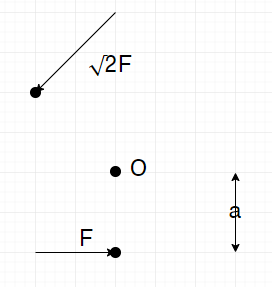Varignon's theorem statesVarignon's theorem states that
"If many coplanar forces are acting on a body, then the algebraic sum of torques of all the forces about a point in the plane of the forces is equal to the torque of their resultant about the same point."
Consider the following case:
Let's consider net moment about the point O.
Algebraic sum of torques gives us √2F√2a + Fa = 3Fa
But resultant of the two forces = F in downward direction gives us the torque Fa
Clearly Varignon's theorem breaks down in this case. I've read elsewhere that Varignon's thorem doesn't apply for cases where a couple of forces is involved. And that's obvious. Because resultant of couple is 0 force which gives 0 torque - and that is wrong.
But in this case, the two forces don't seem to form a couple. The horizontal component of √2F force does form a couple with the bottom force, but that way, in a generalised problem with n forces, many components can form a couple. So how do we know when not to apply varignon's theorem?

